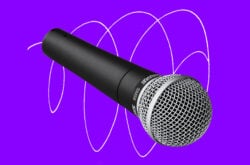Binaural recordings are typically made using a dummy head with mics inside that replicate the position and distance of human eardrums.
When you listen back to them on headphones, they sound as though the sounds are really occurring around your head. If you’re unfamiliar with the conceptual and technical details of binaural audio, check out our blog post on the subject. Recently, binaural recordings have become particularly relevant due to the popularity of creating audio with ASMR (autonomous sensory meridian response) triggers.
While they are many dummy heads with mics specifically manufactured for binaural recording, they can be very expensive (the popular Neumann KU 100 dummy head is currently priced at $8,400), especially for a fairly niche type of sound. Building your own DIY dummy head to test out these recording techniques might sound intimidating, but it actually isn’t all that hard to do – in this blog post, we walk through how we created ours.
Here’s the equipment you’ll need:
- A silicone dummy head
- Silicone ears
- A power drill, with a smaller standard bit and a spade bit for creating space for the mics
- A scalpel
- Epoxy (we used Loctite’s 5-Minute Epoxy)
- A drop cloth
- Microphones (we used a matched pair of Apex 185b pencil mics)
- Plastic wrap
- Some duct tape
- Two metal skewers
- A vacuum
- Computer duster
We found all of this gear for a total of around $250, not counting the drill which we borrowed from a kind colleague.
Preparing your workspace
First things first: if you’re not an adult, get an adult to help you with this. If you’re an adult, it’s still probably a good idea to get another adult to help you with this, especially if you’re not used to using sharp implements or power tools. Second things second: clear out your workspace and put down a drop cloth. This will make your life a lot easier when it’s time to clean up.
Preparing the binaural dummy head
To achieve the best possible binaural effect, you’ll want to use ears that are as lifelike as possible. Many dummy heads (including the one we got from Amazon) do have ears, but they might be too small or unrealistic. For our dummy head build, we cut the ears off of the head using a scalpel, then replaced them with another pair of silicone costume ears from Etsy.

The next order of business is to use the drill to hollow out the head and create an ear canal for the mic to fit into. First, gently slide the metal skewers to plan out where you’ll drill the ear canal. Make sure that they don’t intersect, or else the mics won’t fit. Your objective here is to find an angle through the inside of the head, such that the mics can fit inside with their diaphragms pointed toward the hole in the silicone ear, held fast by a small amount of tension from the existing foam. After you’re satisfied with your plan for where you’ll create the ear canal holes, remove the skewers and drill through the silicone and foam of the dummy head at the same angle.
Once you’ve drilled a guide hole, clear out the rest of the foam using a spade bit. To ensure the best possible fit for the mics, the diameter of the spade bit should be similar to the diameter of whatever microphones you’re using. Use the vacuum and computer duster to remove any errant bits of foam from the ear canal.
At this point, it’s probably a good idea to test your mics to make sure they’ll fit into the ear canal. Wrap the head of the mic in plastic wrap so that no foam gets inside, as this might damage the mic’s components.
Preparing the ears
Next, we’ll get the ears ready to go onto the head. You’ll need to drill through the ears to create a hole linking the ear canal to the outside world. Use the drill hole to get started, and then clean up the hole using the scalpel.

To attach the ears to the rest of the head, we found it necessary to cut off some of the silicone backing attached to the ear model. Your mileage may vary, depending on which ears you use. When you have a relatively flat surface on the back of the ears, go ahead and apply the epoxy, connect the ear to the head, and hold it still for about five minutes. Do one ear at a time. If you want, you could use a rubber band or a piece of string to hold the ears in place and take a break while you wait for the epoxy to dry.
Final assembly
Now it’s time to slide the mics into the head. Before you start, check to make sure that the pad or HPF switches on the mic (if they exist on the mics you chose) are both in the same position. Again, we’d recommend using the plastic wrap to protect the mic from any excess foam.
Ideally, the back of the mic will stick out an inch or two from the rest of the head, giving you an easy place to connect an XLR cable to test the recording. You may want to consider using a scalpel to make the ear canal hole a little bigger to match the mic. If the fit doesn’t seem tight, you could also pad the inside of the ear canal with a bit of rolled-up duct tape to increase tension.
Once the mics fit in the head just so, you should have a working binaural dummy head. To test it out yourself, open your DAW and pan the two inputs coming from the mics inside your dummy head to the hard left and hard right, depending on which ear corresponds to which mic. Remember that the audio may sound a bit strange coming from speakers, so use headphones when you test. Then, find a cool wig, connect your cables, and have fun creating your own binaural recordings!

What does it sound like?
Finally, let’s try using the head to capture some binaural recordings. Here’s the sound of a Pop Rocks bag being ripped open, followed by the sound of the Pop Rocks going off inside an ASMR artist’s mouth:
And here’s the sound of a chef’s knife running up and down a honing steel to realign the edge of the blade after use:
Not bad!
Do you have any questions regarding our process? Let us know in the comments below.
Explore royalty-free sounds from leading artists, producers, and sound designers:
September 9, 2019



